
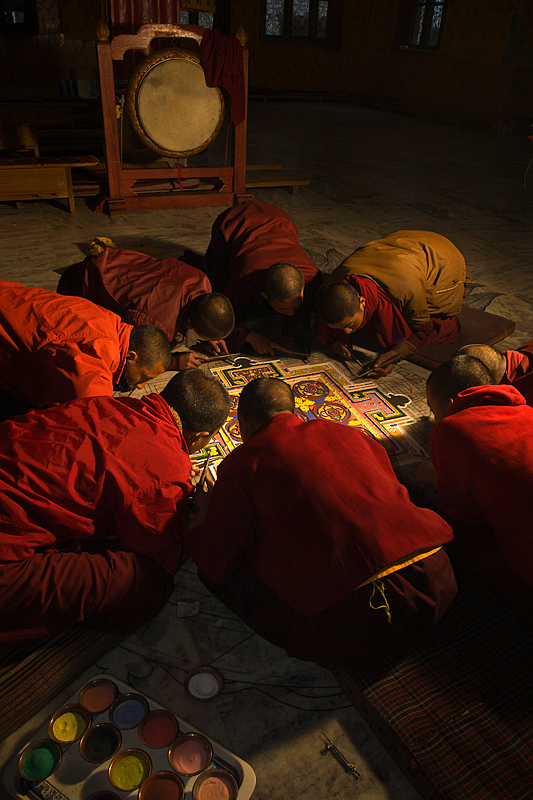
Stepping inside a private monastery in Bhutan last November, we happened upon this scene—a group of young monks bent over the floor creating an intricate mandala. First thought, wow, how cool to finally see this…then, do you suppose we can photograph it? Great, now how? The challenge was the lack of natural light. At 5pm, up in the Himalayan mountains, there’s not much daylight left, especially inside a temple that only has a row of windows at the far end of the large room. No wonder the monks were scrutinizing their work, eyes inches from the floor. If I wanted to capture this scene, I knew I’d be dependent on flash.
I cranked up the ISO to 800, and set up pocket wizards on my off-camera flash and camera body. I asked the guide to hold the flash and aim it into the gold side of a medium sized 5-in-1 reflector just outside the frame. The reason I wanted to bounce light into a reflector was to broaden the light source and diffuse or scatter the light. I chose the gold side of the relector to add a little warmth to the overall scene, mimicing the candlelight elsewhere in the room.
(Quick reference: Think of the sun as a giant light source. Being very far away from a subject on the ground, it creates harsh light, with hard shadows. In contrast, think of a portrait taken In a studio. When a softbox is placed very close to the subject, the broad light source produces soft light that wraps around the person, lessening contrast and shadows.)

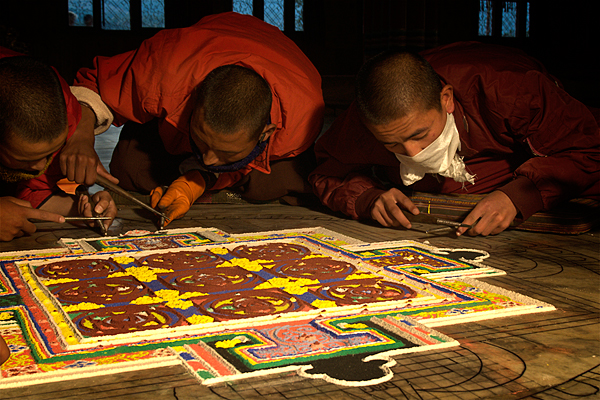
Using the manual setting on the flash I began at 1/4 power and experimented with flash output and positioning of the light. It took little time pantomining how far the guide should hold the flash from the reflector (too close and the light won’t broaden) and from what angle. Thankfully, private guides in Bhutan are very eager to help! I asked my guide, Chimi, to hold the reflector about 3-4 feet away from the closest monk, knowing that the closer the light was to my subject, the softer the light would be. And it would also produce greater light falloff between the subject and the background. I was striving to light the subject sufficiently, yet keep the scene fairly dark and dramatic to evoke the mysterious mood and hushed atmosphere that we felt watching the monks create their magic.
Once the light on the scene seemed pleasing to my eye, I asked Chimi to stay put, aiming the flash into the reflector, while I moved around the circle concentrating on different compositions, actions and details from various angles. Using pocket wizards allowed me the freedom to move around and trigger the flash remotely without worrying about interfering with the infrared signal between the camera and flash.

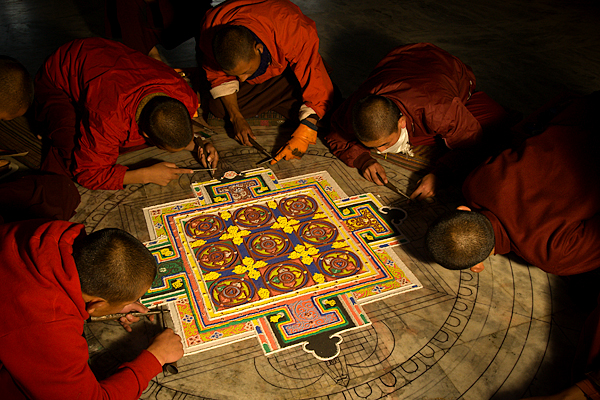
Bouncing the light into the reflector created enough illumination of the central subject—monk faces, fingers and their sand painting—but fell off rather quickly, leaving the surrounding edges quite dark. Which I rather liked. It kept the focus on the mandala and hid the background clutter. Had I simply pointed my flash at the scene, without bouncing it into a reflector or softening it through a diffuser, it would have dissipated any drama.
A reflector is singularly my favorite lighting tool on the road. Handy to use with the sun or a flash. Portable! Easy to pop open and use on the fly. And fun to experiment with the direction and quality of light (making it harsher/softer). When traveling, I never leave home without it.
You never know when you might enter a scene such as this…

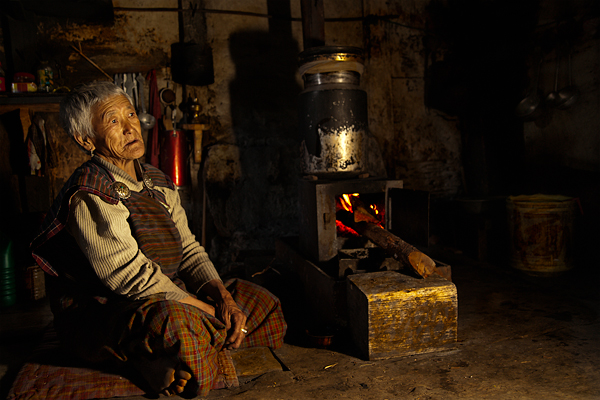
This Bhutanese woman was sitting in her home in Ogyen Choling, a tiny rural hillside village reached by foot on an hour-long hike. Her home was quite dark, as it had no electricity and just one window. I metered the ambient light, underexposing around 2 stops, and bounced my flash into a 5-in-1 reflector held just outside the frame on my right. Note how sidelighting increases the textures in the image, and also adds dimension to the scene.
Or this…

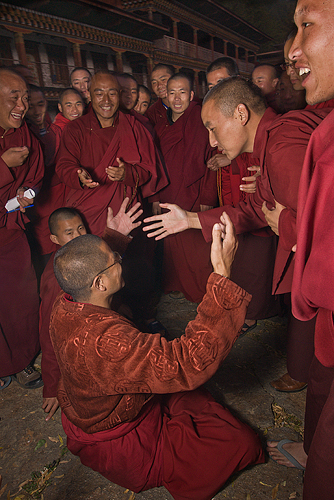
A monk debate was taking place outside in the courtyard of a private monastery in Jakar, Bumthang Valley, Bhutan. I kneeled down behind the visiting Lama and bounced an off-camera flash into the white side of a 5-in-1 reflector.
This…

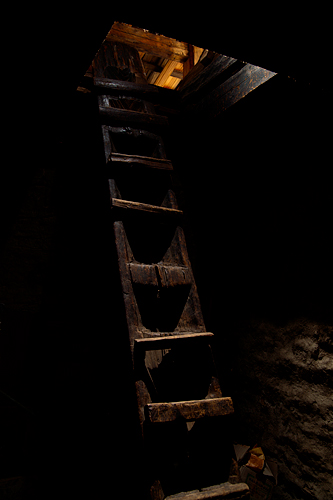
Chimi spotted me looking at this staircase as we were leaving a home where we had been invited in to observe an annual house blessing ritual in Shingkar village. It was he who suggested that he climb to the top and bounce my flash into a reflector aimed down on the stairs. I was delighted! How wonderful it was to have a guide who understood lighting, loved being my assistant, and offered ideas of his own. Thanks again, Chimi!! You rock.
Or even this.

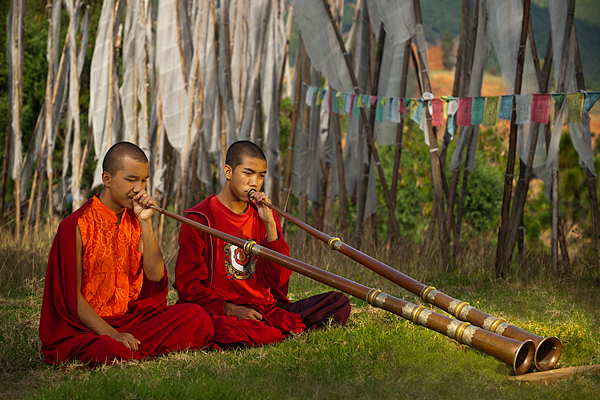
When we visited the Divine Madman’s temple, we saw monks practicing their horns in pairs scattered around the lawn. Although this was taken at midday, I used flash to help make the subjects pop. I exposed for the ambient light (using manual mode on my camera) and simply added supplemental light by bouncing my flash into the gold side of a 5-in-1 reflector. Again, I experimented with the manual setting of the flash, starting with ¼ power, and increasing the power until I was happy with the results. I like the way their colors pop and how the monks and their trumpets stand out from the background.
Have a photo to share where you bounced an off-camera flash into a reflector? Email me, and I’ll post it on our blog!


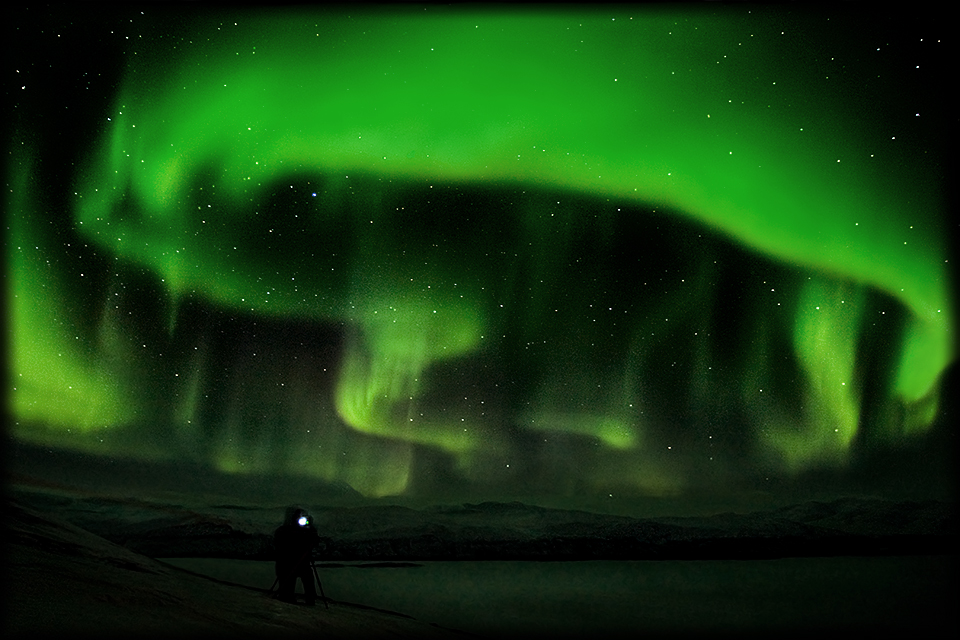
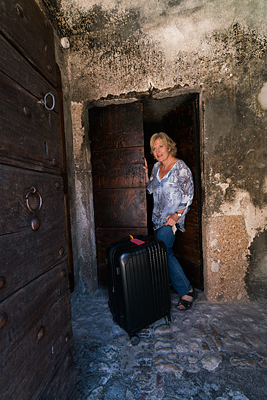
Katie Bates - Kim and David,
I don’t know which one of you wrote this piece on using reflectors, but I really enjoyed it. I just took a day-long seminar on speedlights and learned a lot about using just one light, which is what I was particularly interested in for travel photography. I hope to be at least marginally up to the task by the time we get to Iceland.
thanks,
Katie
ines - Amazing pictures, I totally love your work.
Elizabeth Parker - Can you recommend a specific reflector and a place to purchase it. I really liked the one David showed me in Portugal, but when I look for it on-line I am not sure it is the same . I remember white, gold and silver in a black case – is that right?
Thanks!
chime dorji - Dear Kim,
firstly it is nice to see your photography travel blog.
i am happy that you really like my suggestion on taking the picture of the staircase.
i sure did learn lot from your photography too.
cheers
chime
admin - Hi Betsy,
I like the Opteka 43″ 5-in-1 Collapsible Disc Reflector, Translucent, White, Black, Silver, Gold, with Carrying Case.
I got mine on Amazon for $26+/-
A lot of reflectors will give you Gold and Gold/Silver Mix. I much prefer to have (1) gold and (1) white surface. With Silver, Gold, and White you have a lot of fleixibility.
Also, the translucent inner frame is great for diffusion and is every bit as useful as the reflectors. In fact, if you get two, you can use 1 to soften hard light on your subject, and the other to bounce in broad soft directional light.
Dave
Sherrae - Thanks for the explainations. I have just started to experiment more with my flash and bouncing it off different things. I was trying to figure out how to bounce it off my reflector…trying to figure out the different effects of chaning the distance…your examples were inspiring and you expalined well this concept…excited to try more!
Chris - I am heading to east Asia in a few weeks and am considering taking a reflector with me … and I especially intend to do so now after reading this! I love your photos! My only concern with taking a reflector is portability — I’m trying to travel discretely gear wise. What are your thoughts on using a smaller 22″ reflector (that folds down to 8″) for travel work?
admin - That’s the beauty of using reflectors–they fold down to nothing! I keep mine in a pocket of my shoulder holster camera bag for easy access. I’d go with the largest size you can discreetly carry in whatever camera bag you use.